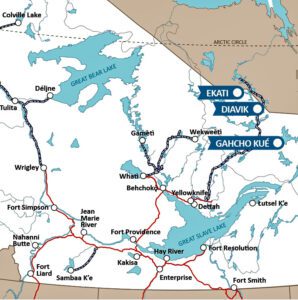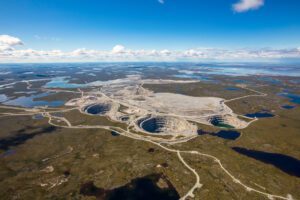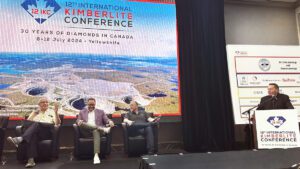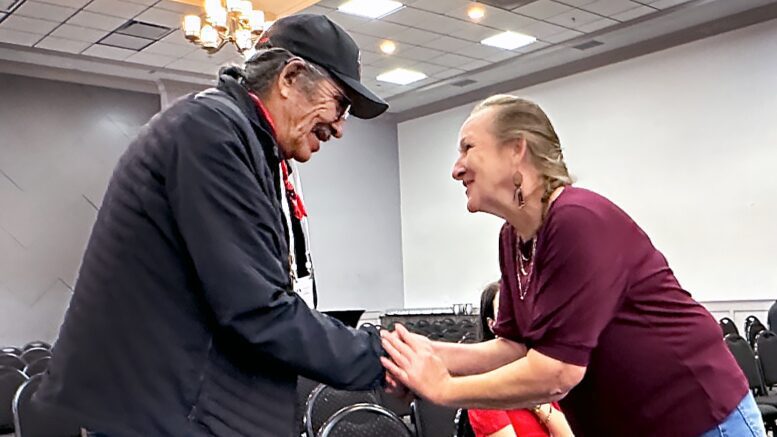Diamonds are considered to be the universal symbol of love and wealth.
But after nearly three decades of watching massive diamond mines blast deep into its traditional hunting grounds, the Łutselk’è Dene First Nation feels slighted, as it has little to show for agreeing to the drilling in the 1990’s.
In fact, the only truly noticeable change is the absence of caribou, a main food source for the fly-in First Nation on the East Arm of Great Slave Lake.
On Sunday, Łutselk’è Dene First Nation Sub-Chief John Catholique stood at the audience microphone at the first day of the week-long 12th International Kimberlite Conference and spoke in very blunt terms about diamond mining.

A locator map showing the three operating diamond mines, and the location of Łutsel K’e. (Image courtesy of GNWT)
“For aboriginal people, it’s like there’s no benefits — 30 years and we look at our community and we tell ourselves, tell our members, what did we get out of it? We look around our community, it’s still the same, dusty roads, and the houses are pretty well the same,” said Catholique.
“We have to do better, especially for the Dene side — billions of dollars being made there, but for us, you know, we got nothing to show for it.
“So I keep telling my community, you know, we have to do better the second time around. We need to understand investment benefit, royalties, joint ventures. When you give somebody something like that without understanding it, good chance they’re not going to benefit, and that’s what happened here. So, the second time around, you know we got to do better, way better. Or else, nothing’s going to happen.”
The session was called, “An Indigenous Perspective on 30 Years of Diamonds in Canada,” and was ironically held in the Caribou Room at the Chateau Nova Hotel.
In front of approximately 100 industry leaders, politicians and mining technology experts, Catholique explained how the three active existing diamond mines — Gahcho Kue, Ekati and Diavik – still disrupt the migration routes of caribou.
“Caribou is our main source of food, and it’s been like that for hundreds and thousands of years. But since 1997, caribou have never come to our community. It used to be around the community, there was so much caribou we had to chase them off the airport so planes could land. That’s how much caribou there was. And when they built that mine right of the migration route caribou. Caribou took a different route.
“So today we have to go about five hours by SkiDoo or to get our food, harvest our food. So those developments are hindering our way of life, causing much grief, but at the same time, we try to be positive.”
The Łutselk’è Dene First Nation has about 800 members, with some 300 living in the community. It’s part of the Akaitcho Dene First Nations.

Ekati Diamond Mine. (Photo courtesy of Burgundy Diamond Mines)
Łutselk’è is one of the closest communities to the NWT’s three active diamond mines, and it has signed a type of impact benefit agreement with each one.
The International Kimberlite Conference’s first session heard about how Indigenous governments and development corporations should work to attract more investment into mining projects in the NWT.
There was general agreement that all parties — including indigenous communities, corporations, GNWT and federal government — should collaborate to make the NWT an attractive jurisdiction for resource development and investment.
Since it turns out diamonds are likely not forever in the Northwest Territories, the focus is shifting to smaller mineral and metals mines, such as NICO, Prairie Creek, and Pine Point.
The 12th Kimberlite Conference brings together hundreds of geoscientists from both the academic and exploration/mining communities to share their knowledge, enjoy scientific debate and to further understanding of kimberlites, diamonds and related subjects. The conference will have field trips to the diamond mines.
The two adjacent conference hotels, the Explorer and the Chateau Nova, will host all of the technical sessions.
EXTRA: Listen to panelists answer the question posed by moderator Wally Schumann: “What does the next generation of mining in the North look like, and how do you see Indigenous development companies participating?”

Kimberlite Conference opening session on Sunday, with (left to right): Mark Whitford, North Slave Métis Alliance president; Mark Lewis, Det’on Chopresident and CEO; Paul Gruner, Tlicho Investment Corporation president and CEO; and former NWT cabinet minister Wally Schumann, now a mining industry consultant. (James O’Connor/CKLB)





